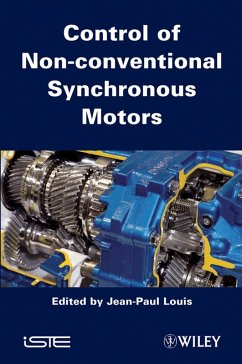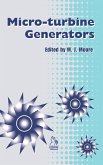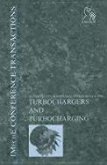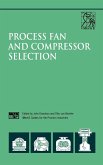Control of Non-Conventional Synchronous Motors
Herausgeber: Louis, Jean-Paul
Control of Non-Conventional Synchronous Motors
Herausgeber: Louis, Jean-Paul
- Gebundenes Buch
- Merkliste
- Auf die Merkliste
- Bewerten Bewerten
- Teilen
- Produkt teilen
- Produkterinnerung
- Produkterinnerung
Classical synchronous motors are the most effective device to drive industrial production systems and robots with precision and rapidity. However, numerous applications require efficient controls in non-conventional situations. Firstly, this is the case with synchronous motors supplied by thyristor line-commutated inverters, or with synchronous motors with faults on one or several phases. Secondly, many drive systems use non-conventional motors such as polyphase (more than three phases) synchronous motors, synchronous motors with double excitation, permanent magnet linear synchronous motors,…mehr
Andere Kunden interessierten sich auch für
![Gearing, Transmissions, and Mechanical Systems Gearing, Transmissions, and Mechanical Systems]() Gearing, Transmissions, and Mechanical Systems811,99 €
Gearing, Transmissions, and Mechanical Systems811,99 €![Integrated Powertrains and Their Control Integrated Powertrains and Their Control]() ND VaughanIntegrated Powertrains and Their Control128,99 €
ND VaughanIntegrated Powertrains and Their Control128,99 €![Micro-Turbine Generators Micro-Turbine Generators]() MJ MooreMicro-Turbine Generators140,99 €
MJ MooreMicro-Turbine Generators140,99 €![Turbochargers and Turbocharging Turbochargers and Turbocharging]() Imeche (Institution of Mechanical Engineers)Turbochargers and Turbocharging449,99 €
Imeche (Institution of Mechanical Engineers)Turbochargers and Turbocharging449,99 €![Engineers' Guide to Rotating Equipment Engineers' Guide to Rotating Equipment]() Clifford MatthewsEngineers' Guide to Rotating Equipment110,99 €
Clifford MatthewsEngineers' Guide to Rotating Equipment110,99 €![Process Fan and Compressor Selection Process Fan and Compressor Selection]() J DavidsonProcess Fan and Compressor Selection202,99 €
J DavidsonProcess Fan and Compressor Selection202,99 €![Icwim 5, Proceedings of the International Conference on Heavy Vehicles Icwim 5, Proceedings of the International Conference on Heavy Vehicles]() B JacobIcwim 5, Proceedings of the International Conference on Heavy Vehicles280,99 €
B JacobIcwim 5, Proceedings of the International Conference on Heavy Vehicles280,99 €-
-
-
Classical synchronous motors are the most effective device to drive industrial production systems and robots with precision and rapidity. However, numerous applications require efficient controls in non-conventional situations. Firstly, this is the case with synchronous motors supplied by thyristor line-commutated inverters, or with synchronous motors with faults on one or several phases. Secondly, many drive systems use non-conventional motors such as polyphase (more than three phases) synchronous motors, synchronous motors with double excitation, permanent magnet linear synchronous motors, synchronous and switched reluctance motors, stepping motors and piezoelectric motors. This book presents efficient controls to improve the use of these non-conventional motors.
Produktdetails
- Produktdetails
- Verlag: Wiley
- Seitenzahl: 416
- Erscheinungstermin: 17. Januar 2012
- Englisch
- Abmessung: 236mm x 155mm x 25mm
- Gewicht: 617g
- ISBN-13: 9781848213319
- ISBN-10: 184821331X
- Artikelnr.: 34790183
- Herstellerkennzeichnung
- Libri GmbH
- Europaallee 1
- 36244 Bad Hersfeld
- gpsr@libri.de
- Verlag: Wiley
- Seitenzahl: 416
- Erscheinungstermin: 17. Januar 2012
- Englisch
- Abmessung: 236mm x 155mm x 25mm
- Gewicht: 617g
- ISBN-13: 9781848213319
- ISBN-10: 184821331X
- Artikelnr.: 34790183
- Herstellerkennzeichnung
- Libri GmbH
- Europaallee 1
- 36244 Bad Hersfeld
- gpsr@libri.de
Jean-Paul Louis is currently Emeritus Professor at École normale supérieure de Cachan (ENS Cachan, UniverSud Paris, France). He is Associate Editor of the European Journal of Electrical Engineering (Hermes). His teaching and research concern modeling and control of electrical systems.
Introduction xi
Jean-Paul LOUIS
Chapter 1. Self-controlled Synchronous Motor: Principles of Function and
Simplified Control Model 1
Francis LABRIQUE and François BAUDART
1.1. Introduction 1
1.2. Design aspects specific to the self-controlled synchronous machine 2
1.3. Simplified model for the study of steady state operation 3
1.4. Study of steady-state operation 6
1.5. Operation at nominal speed, voltage and current 12
1.6. Operation with a torque smaller than the nominal torque 15
1.7. Operation with a speed below the nominal speed 15
1.8. Running as a generator 16
1.9. Equivalence of a machine with a commutator and brushes 17
1.10. Equations inferred from the theory of circuits with sliding contacts
22
1.11. Evaluation of alternating currents circulating in steady state in the
damper windings 26
1.12. Transposition of the study to the case of a negative rotational speed
28
1.13. Variant of the base assembly 28
1.14. Conclusion 29
1.15. List of the main symbols used 29
1.16. Bibliography 30
Chapter 2. Self-controlled Synchronous Motor: Dynamic Model Including the
Behavior of Damper Windings and Commutation Overlap 33
Ernest MATAGNE
2.1. Introduction 33
2.2. Choice of the expression of Nk 35
2.3. Expression of fluxes 40
2.4. General properties of coefficients , and 46
2.5. Electrical dynamic equations 48
2.6. Expression of electromechanical variables 51
2.7. Expression of torque 53
2.8. Writing of equations in terms of coenergy 54
2.9. Application to control 56
2.10. Conclusion 60
2.11. Appendix 1: value of coefficients , and 60
2.12. Appendix 2: derivatives of coefficients , and 61
2.13. Appendix 3: simplifications for small ¿62
2.14. Appendix 4: List of the main symbols used in Chapters 1 and 2 63
2.15. Bibliography 65
Chapter 3. Synchronous Machines in Degraded Mode 67
Damien FLIELLER, Ngac Ky NGUYEN, Hervé SCHWAB and Guy STURTZER
3.1. General introduction 67
3.2. Analysis of the main causes of failure 68
3.3. Reliability of a permanent magnet synchronous motors drive 72
3.4. Conclusion 76
3.5. Optimal supplies of permanent magnet synchronous machines in the
presence of faults 77
3.6. Supplies of faulty synchronous machines with non-sinusoidal back
electromagnetic force 77
3.7. Experimental learning strategy in closed loop to obtain optimal
currents in all cases 113
3.8. Simulation results 116
3.9. General conclusion 118
3.10. Glossary 119
3.11. Bibliography 121
Chapter 4. Control of the Double-star Synchronous Machine Supplied by PWM
Inverters 125
Mohamed Fouad BENKHORIS
4.1. Introduction 125
4.2. Description of the electrical actuator 127
4.3. Basic equations 128
4.4. Dynamic models of the double-star synchronous machine 131
4.5. Control of the double-star synchronous machine 146
4.6. Bibliography 158
Chapter 5. Vectorial Modeling and Control of Multiphase Machines with
Non-salient Poles Supplied by an Inverter 161
Xavier KESTELYN and Éric SEMAIL
5.1. Introduction and presentation of the electrical machines 161
5.2. Control model of inverter-fed permanent magnet synchronous machines
163
5.3. Torque control of multiphase machines 189
5.4. Modeling and torque control of multiphase machines in degraded supply
mode 203
5.5. Bibliography 204
Chapter 6. Hybrid Excitation Synchronous Machines 207
Nicolas PATIN and Lionel VIDO
6.1. Description 207
6.2. Modeling with the aim of control 220
6.3. Control by model inversion 230
6.4. Overspeed and flux weakening of synchronous machines 235
6.4. Conclusion 237
6.5. Bibliography 239
Chapter 7. Advanced Control of the Linear Synchronous Motor 241
Ghislain REMY and Pierre-Jean BARRE
7.1. Introduction 241
7.2. Classical control of linear motors 253
7.3. Advanced control of linear motors 265
7.4. Conclusion 279
7.5. Nomenclature 280
7.6. Acknowledgment 281
7.7. Bibliography 281
7.8. Appendix: LMD10-050 Datasheet of ETEL 285
Chapter 8. Variable Reluctance Machines: Modeling and Control 287
Mickael HILAIRET, Thierry LUBIN and Abdelmounaïm TOUNZI
8.1. Introduction 287
8.2. Synchronous reluctance machines 289
8.3. Switched reluctance machines 303
8.4. Conclusion 323
8.5. Bibliography 323
Chapter 9. Control of the Stepping Motor 329
Bruno ROBERT and Moez FEKI
9.1. Introduction 329
9.2. Modeling 329
9.3. Control in open loop 335
9.4. Controls in closed loop 350
9.5. Advanced control: the control of chaos 361
9.6. Bibliography 371
Chapter 10. Control of Piezoelectric Actuators 375
Frédéric GIRAUD and Betty LEMAIRE-SEMAIL
10.1. Introduction 375
10.2. Causal model in the supplied voltage referential 380
10.3. Causal model in the referential of the traveling wave 389
10.4. Control based on a behavioral model 400
10.5. Controls based on a knowledge model 401
10.6. Conclusion 407
10.7. Bibliography 407
List of Authors 411
Index 413
Jean-Paul LOUIS
Chapter 1. Self-controlled Synchronous Motor: Principles of Function and
Simplified Control Model 1
Francis LABRIQUE and François BAUDART
1.1. Introduction 1
1.2. Design aspects specific to the self-controlled synchronous machine 2
1.3. Simplified model for the study of steady state operation 3
1.4. Study of steady-state operation 6
1.5. Operation at nominal speed, voltage and current 12
1.6. Operation with a torque smaller than the nominal torque 15
1.7. Operation with a speed below the nominal speed 15
1.8. Running as a generator 16
1.9. Equivalence of a machine with a commutator and brushes 17
1.10. Equations inferred from the theory of circuits with sliding contacts
22
1.11. Evaluation of alternating currents circulating in steady state in the
damper windings 26
1.12. Transposition of the study to the case of a negative rotational speed
28
1.13. Variant of the base assembly 28
1.14. Conclusion 29
1.15. List of the main symbols used 29
1.16. Bibliography 30
Chapter 2. Self-controlled Synchronous Motor: Dynamic Model Including the
Behavior of Damper Windings and Commutation Overlap 33
Ernest MATAGNE
2.1. Introduction 33
2.2. Choice of the expression of Nk 35
2.3. Expression of fluxes 40
2.4. General properties of coefficients , and 46
2.5. Electrical dynamic equations 48
2.6. Expression of electromechanical variables 51
2.7. Expression of torque 53
2.8. Writing of equations in terms of coenergy 54
2.9. Application to control 56
2.10. Conclusion 60
2.11. Appendix 1: value of coefficients , and 60
2.12. Appendix 2: derivatives of coefficients , and 61
2.13. Appendix 3: simplifications for small ¿62
2.14. Appendix 4: List of the main symbols used in Chapters 1 and 2 63
2.15. Bibliography 65
Chapter 3. Synchronous Machines in Degraded Mode 67
Damien FLIELLER, Ngac Ky NGUYEN, Hervé SCHWAB and Guy STURTZER
3.1. General introduction 67
3.2. Analysis of the main causes of failure 68
3.3. Reliability of a permanent magnet synchronous motors drive 72
3.4. Conclusion 76
3.5. Optimal supplies of permanent magnet synchronous machines in the
presence of faults 77
3.6. Supplies of faulty synchronous machines with non-sinusoidal back
electromagnetic force 77
3.7. Experimental learning strategy in closed loop to obtain optimal
currents in all cases 113
3.8. Simulation results 116
3.9. General conclusion 118
3.10. Glossary 119
3.11. Bibliography 121
Chapter 4. Control of the Double-star Synchronous Machine Supplied by PWM
Inverters 125
Mohamed Fouad BENKHORIS
4.1. Introduction 125
4.2. Description of the electrical actuator 127
4.3. Basic equations 128
4.4. Dynamic models of the double-star synchronous machine 131
4.5. Control of the double-star synchronous machine 146
4.6. Bibliography 158
Chapter 5. Vectorial Modeling and Control of Multiphase Machines with
Non-salient Poles Supplied by an Inverter 161
Xavier KESTELYN and Éric SEMAIL
5.1. Introduction and presentation of the electrical machines 161
5.2. Control model of inverter-fed permanent magnet synchronous machines
163
5.3. Torque control of multiphase machines 189
5.4. Modeling and torque control of multiphase machines in degraded supply
mode 203
5.5. Bibliography 204
Chapter 6. Hybrid Excitation Synchronous Machines 207
Nicolas PATIN and Lionel VIDO
6.1. Description 207
6.2. Modeling with the aim of control 220
6.3. Control by model inversion 230
6.4. Overspeed and flux weakening of synchronous machines 235
6.4. Conclusion 237
6.5. Bibliography 239
Chapter 7. Advanced Control of the Linear Synchronous Motor 241
Ghislain REMY and Pierre-Jean BARRE
7.1. Introduction 241
7.2. Classical control of linear motors 253
7.3. Advanced control of linear motors 265
7.4. Conclusion 279
7.5. Nomenclature 280
7.6. Acknowledgment 281
7.7. Bibliography 281
7.8. Appendix: LMD10-050 Datasheet of ETEL 285
Chapter 8. Variable Reluctance Machines: Modeling and Control 287
Mickael HILAIRET, Thierry LUBIN and Abdelmounaïm TOUNZI
8.1. Introduction 287
8.2. Synchronous reluctance machines 289
8.3. Switched reluctance machines 303
8.4. Conclusion 323
8.5. Bibliography 323
Chapter 9. Control of the Stepping Motor 329
Bruno ROBERT and Moez FEKI
9.1. Introduction 329
9.2. Modeling 329
9.3. Control in open loop 335
9.4. Controls in closed loop 350
9.5. Advanced control: the control of chaos 361
9.6. Bibliography 371
Chapter 10. Control of Piezoelectric Actuators 375
Frédéric GIRAUD and Betty LEMAIRE-SEMAIL
10.1. Introduction 375
10.2. Causal model in the supplied voltage referential 380
10.3. Causal model in the referential of the traveling wave 389
10.4. Control based on a behavioral model 400
10.5. Controls based on a knowledge model 401
10.6. Conclusion 407
10.7. Bibliography 407
List of Authors 411
Index 413
Introduction xi
Jean-Paul LOUIS
Chapter 1. Self-controlled Synchronous Motor: Principles of Function and
Simplified Control Model 1
Francis LABRIQUE and François BAUDART
1.1. Introduction 1
1.2. Design aspects specific to the self-controlled synchronous machine 2
1.3. Simplified model for the study of steady state operation 3
1.4. Study of steady-state operation 6
1.5. Operation at nominal speed, voltage and current 12
1.6. Operation with a torque smaller than the nominal torque 15
1.7. Operation with a speed below the nominal speed 15
1.8. Running as a generator 16
1.9. Equivalence of a machine with a commutator and brushes 17
1.10. Equations inferred from the theory of circuits with sliding contacts
22
1.11. Evaluation of alternating currents circulating in steady state in the
damper windings 26
1.12. Transposition of the study to the case of a negative rotational speed
28
1.13. Variant of the base assembly 28
1.14. Conclusion 29
1.15. List of the main symbols used 29
1.16. Bibliography 30
Chapter 2. Self-controlled Synchronous Motor: Dynamic Model Including the
Behavior of Damper Windings and Commutation Overlap 33
Ernest MATAGNE
2.1. Introduction 33
2.2. Choice of the expression of Nk 35
2.3. Expression of fluxes 40
2.4. General properties of coefficients , and 46
2.5. Electrical dynamic equations 48
2.6. Expression of electromechanical variables 51
2.7. Expression of torque 53
2.8. Writing of equations in terms of coenergy 54
2.9. Application to control 56
2.10. Conclusion 60
2.11. Appendix 1: value of coefficients , and 60
2.12. Appendix 2: derivatives of coefficients , and 61
2.13. Appendix 3: simplifications for small ¿62
2.14. Appendix 4: List of the main symbols used in Chapters 1 and 2 63
2.15. Bibliography 65
Chapter 3. Synchronous Machines in Degraded Mode 67
Damien FLIELLER, Ngac Ky NGUYEN, Hervé SCHWAB and Guy STURTZER
3.1. General introduction 67
3.2. Analysis of the main causes of failure 68
3.3. Reliability of a permanent magnet synchronous motors drive 72
3.4. Conclusion 76
3.5. Optimal supplies of permanent magnet synchronous machines in the
presence of faults 77
3.6. Supplies of faulty synchronous machines with non-sinusoidal back
electromagnetic force 77
3.7. Experimental learning strategy in closed loop to obtain optimal
currents in all cases 113
3.8. Simulation results 116
3.9. General conclusion 118
3.10. Glossary 119
3.11. Bibliography 121
Chapter 4. Control of the Double-star Synchronous Machine Supplied by PWM
Inverters 125
Mohamed Fouad BENKHORIS
4.1. Introduction 125
4.2. Description of the electrical actuator 127
4.3. Basic equations 128
4.4. Dynamic models of the double-star synchronous machine 131
4.5. Control of the double-star synchronous machine 146
4.6. Bibliography 158
Chapter 5. Vectorial Modeling and Control of Multiphase Machines with
Non-salient Poles Supplied by an Inverter 161
Xavier KESTELYN and Éric SEMAIL
5.1. Introduction and presentation of the electrical machines 161
5.2. Control model of inverter-fed permanent magnet synchronous machines
163
5.3. Torque control of multiphase machines 189
5.4. Modeling and torque control of multiphase machines in degraded supply
mode 203
5.5. Bibliography 204
Chapter 6. Hybrid Excitation Synchronous Machines 207
Nicolas PATIN and Lionel VIDO
6.1. Description 207
6.2. Modeling with the aim of control 220
6.3. Control by model inversion 230
6.4. Overspeed and flux weakening of synchronous machines 235
6.4. Conclusion 237
6.5. Bibliography 239
Chapter 7. Advanced Control of the Linear Synchronous Motor 241
Ghislain REMY and Pierre-Jean BARRE
7.1. Introduction 241
7.2. Classical control of linear motors 253
7.3. Advanced control of linear motors 265
7.4. Conclusion 279
7.5. Nomenclature 280
7.6. Acknowledgment 281
7.7. Bibliography 281
7.8. Appendix: LMD10-050 Datasheet of ETEL 285
Chapter 8. Variable Reluctance Machines: Modeling and Control 287
Mickael HILAIRET, Thierry LUBIN and Abdelmounaïm TOUNZI
8.1. Introduction 287
8.2. Synchronous reluctance machines 289
8.3. Switched reluctance machines 303
8.4. Conclusion 323
8.5. Bibliography 323
Chapter 9. Control of the Stepping Motor 329
Bruno ROBERT and Moez FEKI
9.1. Introduction 329
9.2. Modeling 329
9.3. Control in open loop 335
9.4. Controls in closed loop 350
9.5. Advanced control: the control of chaos 361
9.6. Bibliography 371
Chapter 10. Control of Piezoelectric Actuators 375
Frédéric GIRAUD and Betty LEMAIRE-SEMAIL
10.1. Introduction 375
10.2. Causal model in the supplied voltage referential 380
10.3. Causal model in the referential of the traveling wave 389
10.4. Control based on a behavioral model 400
10.5. Controls based on a knowledge model 401
10.6. Conclusion 407
10.7. Bibliography 407
List of Authors 411
Index 413
Jean-Paul LOUIS
Chapter 1. Self-controlled Synchronous Motor: Principles of Function and
Simplified Control Model 1
Francis LABRIQUE and François BAUDART
1.1. Introduction 1
1.2. Design aspects specific to the self-controlled synchronous machine 2
1.3. Simplified model for the study of steady state operation 3
1.4. Study of steady-state operation 6
1.5. Operation at nominal speed, voltage and current 12
1.6. Operation with a torque smaller than the nominal torque 15
1.7. Operation with a speed below the nominal speed 15
1.8. Running as a generator 16
1.9. Equivalence of a machine with a commutator and brushes 17
1.10. Equations inferred from the theory of circuits with sliding contacts
22
1.11. Evaluation of alternating currents circulating in steady state in the
damper windings 26
1.12. Transposition of the study to the case of a negative rotational speed
28
1.13. Variant of the base assembly 28
1.14. Conclusion 29
1.15. List of the main symbols used 29
1.16. Bibliography 30
Chapter 2. Self-controlled Synchronous Motor: Dynamic Model Including the
Behavior of Damper Windings and Commutation Overlap 33
Ernest MATAGNE
2.1. Introduction 33
2.2. Choice of the expression of Nk 35
2.3. Expression of fluxes 40
2.4. General properties of coefficients , and 46
2.5. Electrical dynamic equations 48
2.6. Expression of electromechanical variables 51
2.7. Expression of torque 53
2.8. Writing of equations in terms of coenergy 54
2.9. Application to control 56
2.10. Conclusion 60
2.11. Appendix 1: value of coefficients , and 60
2.12. Appendix 2: derivatives of coefficients , and 61
2.13. Appendix 3: simplifications for small ¿62
2.14. Appendix 4: List of the main symbols used in Chapters 1 and 2 63
2.15. Bibliography 65
Chapter 3. Synchronous Machines in Degraded Mode 67
Damien FLIELLER, Ngac Ky NGUYEN, Hervé SCHWAB and Guy STURTZER
3.1. General introduction 67
3.2. Analysis of the main causes of failure 68
3.3. Reliability of a permanent magnet synchronous motors drive 72
3.4. Conclusion 76
3.5. Optimal supplies of permanent magnet synchronous machines in the
presence of faults 77
3.6. Supplies of faulty synchronous machines with non-sinusoidal back
electromagnetic force 77
3.7. Experimental learning strategy in closed loop to obtain optimal
currents in all cases 113
3.8. Simulation results 116
3.9. General conclusion 118
3.10. Glossary 119
3.11. Bibliography 121
Chapter 4. Control of the Double-star Synchronous Machine Supplied by PWM
Inverters 125
Mohamed Fouad BENKHORIS
4.1. Introduction 125
4.2. Description of the electrical actuator 127
4.3. Basic equations 128
4.4. Dynamic models of the double-star synchronous machine 131
4.5. Control of the double-star synchronous machine 146
4.6. Bibliography 158
Chapter 5. Vectorial Modeling and Control of Multiphase Machines with
Non-salient Poles Supplied by an Inverter 161
Xavier KESTELYN and Éric SEMAIL
5.1. Introduction and presentation of the electrical machines 161
5.2. Control model of inverter-fed permanent magnet synchronous machines
163
5.3. Torque control of multiphase machines 189
5.4. Modeling and torque control of multiphase machines in degraded supply
mode 203
5.5. Bibliography 204
Chapter 6. Hybrid Excitation Synchronous Machines 207
Nicolas PATIN and Lionel VIDO
6.1. Description 207
6.2. Modeling with the aim of control 220
6.3. Control by model inversion 230
6.4. Overspeed and flux weakening of synchronous machines 235
6.4. Conclusion 237
6.5. Bibliography 239
Chapter 7. Advanced Control of the Linear Synchronous Motor 241
Ghislain REMY and Pierre-Jean BARRE
7.1. Introduction 241
7.2. Classical control of linear motors 253
7.3. Advanced control of linear motors 265
7.4. Conclusion 279
7.5. Nomenclature 280
7.6. Acknowledgment 281
7.7. Bibliography 281
7.8. Appendix: LMD10-050 Datasheet of ETEL 285
Chapter 8. Variable Reluctance Machines: Modeling and Control 287
Mickael HILAIRET, Thierry LUBIN and Abdelmounaïm TOUNZI
8.1. Introduction 287
8.2. Synchronous reluctance machines 289
8.3. Switched reluctance machines 303
8.4. Conclusion 323
8.5. Bibliography 323
Chapter 9. Control of the Stepping Motor 329
Bruno ROBERT and Moez FEKI
9.1. Introduction 329
9.2. Modeling 329
9.3. Control in open loop 335
9.4. Controls in closed loop 350
9.5. Advanced control: the control of chaos 361
9.6. Bibliography 371
Chapter 10. Control of Piezoelectric Actuators 375
Frédéric GIRAUD and Betty LEMAIRE-SEMAIL
10.1. Introduction 375
10.2. Causal model in the supplied voltage referential 380
10.3. Causal model in the referential of the traveling wave 389
10.4. Control based on a behavioral model 400
10.5. Controls based on a knowledge model 401
10.6. Conclusion 407
10.7. Bibliography 407
List of Authors 411
Index 413








